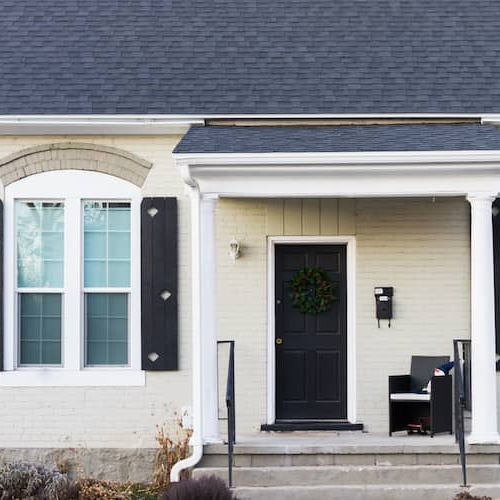How much house can you afford with a VA loan?
Apr 4, 2024
•7-minute read
Veterans, service members and eligible surviving spouses with dreams of homeownership have one of the most favorable loan products at their disposal: the Department of Veterans Affairs (VA) loan.
These loans have low credit requirements and no down payment, helping qualifying buyers afford home purchases across the country. That said, your purchasing power with a VA loan depends on such factors as your financial well-being, location, and interest rate. Here’s how to know how much house you can afford with a VA loan, along with some tips to lower your mortgage payment.
VA Loan Affordability Calculator
The Rocket MortgageⓇ loan affordability calculator can help estimate how much house you can afford with a VA loan. Using information like your income level, desired property type, borrowing history and location, the calculator will estimate what you’re eligible for using a VA loan.
What Are The VA Residual Income Charts and Requirements?
The VA requires borrowers to have a certain amount of discretionary income, also known as residual income, left over after paying major expenses, including the mortgage payment, to cover basic living expenses. The required amount varies based on loan amount, family size, and location.
Residual income looks at leftover money each month after paying all expected expenses, like loans, childcare, and utilities. The VA wants to know that veterans have enough residual income to cover things like gas, food, clothing, and other typical family needs after the mortgage payment.
VA charts, like the one below for loans of $79,999 or less, show how these residual income thresholds differ by family size and region. As you can see, the larger the family size, the greater the residual income threshold.
| Family Size | Northeast | Midwest | South | West |
|---|---|---|---|---|
| 1 | $390 | $382 | $382 | $425 |
| 2 | $654 | $641 | $641 | $713 |
| 3 | $788 | $772 | $772 | $859 |
| 4 | $888 | $868 | $868 | $967 |
| 5 | $921 | $902 | $902 | $1,004 |
| Add $75 for each additional family member up to a family of 7 | ||||
Your VA Loan Depends On Your Financial Circumstances
How much house you can afford with a VA loan depends on your:
- Credit history
- Income
- Property type
- Down payment
These factors will be explored in-depth further in the process. However, there are a few tools you can use to get a quick estimate of what you can afford.
The 28% Rule And VA Loans
One popular method for determining how much VA loan you can afford is the 28% rule, which states that your monthly housing payments should make up no more than 28% of your gross monthly income.
While other factors like your debts and recurring payments can impact how much house you can afford, knowing what 28% of your gross monthly income is can give you a good estimate of how much you can afford to spend on your VA loan payment.
Factors that impact how much house you can afford with a VA loan
The size of your VA loan depends on your financial profile, including monthly debt obligations and income. Remember, the VA doesn’t directly provide mortgages. Instead, it approves private lenders to originate and manage the loans. Therefore, it’s crucial to shop for lenders that service VA loans because each one has slightly different standards. Lenders consider these factors when giving you a VA loan:
Credit score
Your credit score is a numerical representation of your reliability as a borrower, ranging from 300 to 850. Higher scores signify consistent debt payments in the past, indicating to lenders that you’re more likely to make your VA loan payments on time. For this reason, lenders usually have cutoff scores for qualifying borrowers. For example, your lender might require a credit score of 580 or higher to give you a VA loan.
In addition, higher scores often help borrowers obtain lower interest rates. And, a lower interest rate will allow you to get a bigger loan or have a lower monthly mortgage payment. For example, a $300,000 30-year mortgage with a 7% interest rate creates a monthly payment of $1,995 before taxes and insurance. On the other hand, a 5% interest rate for the same loan means you’ll pay $1,610. In this scenario, the 2 percentage points in interest create a difference of $385 per month for the same loan. Therefore, a good credit score can help you get a larger loan.
Income
The larger your income, the more you’ll be able to afford for a monthly mortgage payment. Demonstrating consistent income is crucial for qualifying for a VA loan. Lenders typically require proof of income, such as pay stubs, bank statements, 24-month employment history and documentation for benefits you receive. In addition, lenders use your gross income to calculate debt-to-income ratio, as explained below.
Debt-to-income ratio
Lenders use your debt-to-income (DTI) ratio to assess your borrowing capacity. DTI compares your monthly debt payments, including potential mortgage payments, to your gross monthly income and expresses it as a percentage. This figure helps lenders determine whether you have sufficient income to manage your debt obligations comfortably.
DTI example
You can use DTI to determine how much house you can afford with a VA loan. First, you multiply your income by your lender's maximum allowable DTI (expressed as a decimal) to see how high your combined debt payments and mortgage can be. For example, if your monthly income is $6,500 and the lender's required DTI is no higher than 0.43 (43%), your maximum allowable debt payments would be $6,500 × 0.43 = $2,795. If you have $500 of monthly debt payments, you can get a mortgage with a $2,295 payment and stay within the allowed DTI range.
DTI ratio limits and VA loans
While the VA doesn't impose a DTI limit for loans, your lender likely will. For example, your lender might require borrowers to have a DTI of 45% or lower to qualify for a VA loan. If your DTI exceeds the limit, your lender may provide specific allowances to help you obtain a loan.
VA loans stipulate residual income in the borrower's budget. The required amount depends on your mortgage size, household and location. If your DTI is too high, your lender may still give you a loan if you have 120% residual income. Residual income is the remainder of your gross income after subtracting all of your personal debts and expenses.
For example, say your lender requires $1,500 of residual income for VA borrowers. If your DTI surpasses the lender's limit, you may qualify for the VA loan with 120% of the required residual income, which is $1,800. ($1,500 × 1.2 = $1,800)
Down payment
Your down payment amount also impacts how much house your VA loan will buy. VA loans don’t require a down payment, offering flexibility for borrowers who want minimal upfront costs. The more you put down, the less you’ll need to borrow. Remember, putting 0% down means having a larger principal balance, increasing your monthly payment. Conversely, a hefty down payment will reduce your total balance due and, therefore, your monthly payment.
Down payment example
For example, a $350,000 mortgage with a 30-year term and a 7% interest rate costs $2,328 monthly (not including taxes and insurance). However, a 10% down payment ($35,000) reduces your starting loan balance to $315,000, lowering your monthly payment to $2,095 at the same interest rate. So, a down payment decreases monthly costs and the paid interest over the loan term, which can help a more expensive home fit your budget.
Keep in mind that, while there may not be a down payment required, there is a funding fee that comes with VA loans.
Interest rates
Your mortgage interest rate is essentially the fee that your lender charges you for borrowing money. Your lender will figure in the interest rate when calculating your monthly payment and total loan cost. As a result, affordability decreases when interest rates increase.
Interest rate example
A lower interest rate means a lower monthly payment. For example, a 30-year fixed-rate loan of $400,000 at a 7% interest rate comes out to $2,661 a month in principal and interest. The exact same loan at a 6% interest rate has a monthly payment of $2,398. In this example, one percentage point makes a difference of $263 a month.
Loan term
Your loan term is crucial for your VA loan because it determines how much time you have to pay. The longer the term, the more you can spread out payments, reducing monthly costs. For example, a $250,000 loan with a 15-year term and a 7% interest rate costs $2,247 monthly before taxes and insurance. However, doubling the term to 30 years creates a $1,663 payment, increasing affordability.
Property taxes
Property tax is an additional monthly expense for homeowners. The specific method of calculating property taxes can vary depending on the jurisdiction. However, municipalities usually follow this general process:
1. Property assessment: Assessors determine your property's value based on size, location, condition and comparable sales.
2. Tax rate: The local government sets a millage rate, representing the tax rate per thousand dollars of assessed value. For example, a tax rate of 5 mills (.005) would mean $5 in taxes for every $1,000 of assessed value.
3. Calculation: Multiply your property's assessed value by the tax rate to determine your annual property tax liability. For instance, if your property is assessed at $300,000 and the tax rate is 5 mills (0.005), your annual property tax would be $300,000 × 0.005 = $1,500. Lenders frequently manage property taxes – and homeowners insurance – through an escrow account, paying these expenses on your behalf. Then, they charge borrowers monthly to cover the taxes due. So, in this scenario, your property taxes are $125 per month.
You can lower your property taxes through exemptions. Specifically, the homestead exemption gives a discount on taxes for primary residences. In addition, the senior exemption reduces property taxes for older homeowners, and some municipalities grant property tax exemptions to homeowners with disabilities.
Homeowners insurance
Lastly, homeowners insurance increases monthly housing costs and is typically paid by the lender on your behalf, then charged as part of your monthly payment. Lenders require borrowers to buy homeowners insurance, so it’s mandatory when purchasing a home with a VA loan. Costs vary by company, location, coverage limits, credit history and coverage customizations.
FAQs about VA loan payments
Keep reading for the answers to some frequently asked questions about VA loan payments.
Do I have to pay mortgage insurance with a VA loan?
VA loans don’t require mortgage insurance. Instead, those who take out a VA loan must pay a one-time funding fee equal to 2.15% of the loan amount for first-time home buyers and 3.3% on any additional loans. The VA funding fee can be reduced by making a larger down payment.
What’s an amortization schedule on a VA loan?
A VA loan amortization schedule shows how much of a borrower’s monthly payment goes to the principal balance and interest each month. In the beginning, the majority of the monthly payment will go toward interest. As the principal balance decreases over the life of the loan, more of the payment will be applied to the principal.
The bottom line
How much house you can afford with a VA loan depends on your financial circumstances (including DTI and credit score) and the loan specifics (including term and interest rate). One rule of thumb that may be helpful to follow when determining how much house you can afford with a VA loan is the 28% rule, which says that you should spend no more than 28% of your gross monthly income on your housing payment. Therefore, it’s crucial to establish your financial footing before applying for a loan.
If you’re ready and eligible, you can finance your home purchase with a VA loan by starting the mortgage approval process today.

Ashley Kilroy
Ashley Kilroy is an experienced financial writer. In addition to being a contributing writer at Rocket Homes, she writes for solo entrepreneurs as well as for Fortune 500 companies. Ashley is a finance graduate of the University of Cincinnati. When she isn’t helping people understand their finances, you may find Ashley cage diving with great whites or on safari in South Africa.
Related resources

9-minute read
VA Streamline refinance (VA IRRRL): What is it and how does it work?
A VA IRRRL may be the best option for you if you want lower monthly payments. Read our article to learn more about VA Streamline refinance and how it works.<...
Read more

8-minute read
Buying a second home with a VA loan
VA loans are designed to help military personnel, veterans, and their families buy a primary residence, but there are ways you can use one to buy a second home.
Read more

6-minute read
How many times can you use a VA loan?
There’s no limit to the number of VA loans qualified borrowers can take out, but you usually can’t hold multiple VA loans at once. Let’s break...
Read more